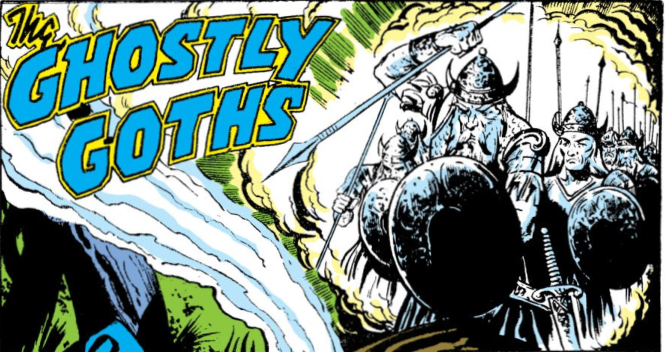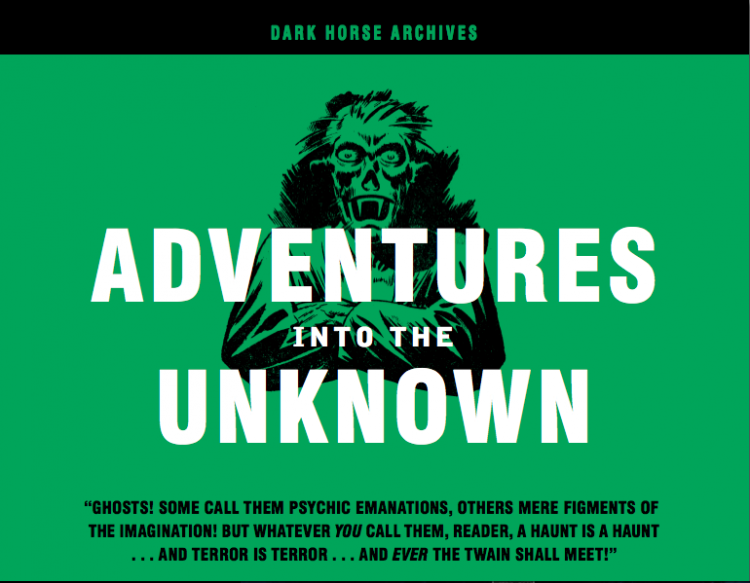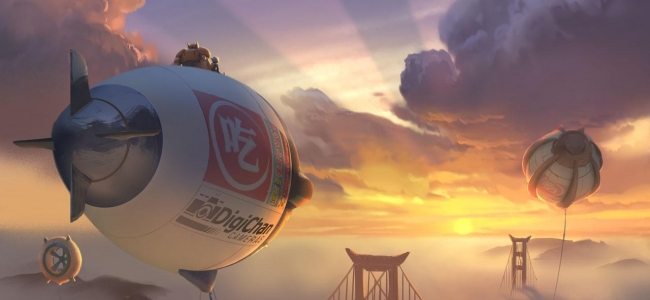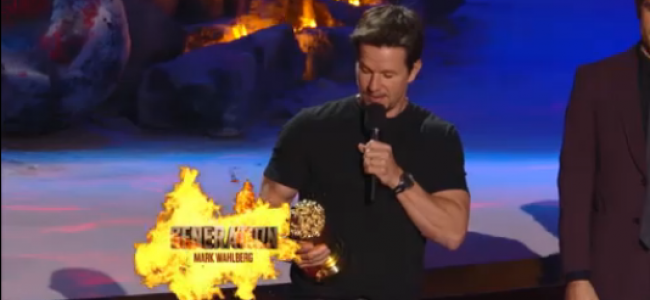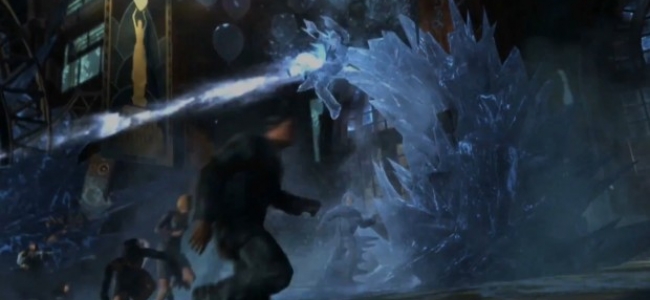Community Post: This article was submitted by a member of our community. Find out how you can publish your own writing here!
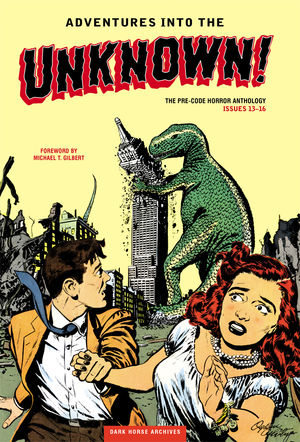 Reprinting issues #13 – 16 of Adventures Into The Unknown, from October 1950 – February 1951
Reprinting issues #13 – 16 of Adventures Into The Unknown, from October 1950 – February 1951
Featuring The Works Of Ken Bald, Richard Case, Bill Ely, Paul Gattuso, Fred Guardineer, Emil Gershwin, Richard E. Hughest, Edvard Moritz, Leonard Starr, Lin Streeter, Charlie Sultan, Ogden Whitney, and Others!
Adventures Into The Unknown, from American Comic Group (ACG), bears the distinction of being the first horror comic book. Its success would go on to inspire other ACG titles like Forbidden Worlds, The Clutching Hand, Gasp!, Midnight Mystery, Out Of The Night, Skeleton Hand, and Unknown World, and would help usher in the horror anthology craze that would yield such dark delights as Tales From The Crypt, Eerie, and Creepy, that would so colour the collective id.
Adventures Into The Unknown Archive #4, the latest in Dark Horse’s classy re-prints, takes this pulp seriously, giving the top-shelf hardcover treatment, along with an informative and passionate intro from comics historian Michael T. Gilbert, creator of the character Mr. Monster and regular columnist for Roy Thomas’ Alter Ego magazine.
Gilbert sets the stage, helping the modern reader to understand the world these comics were coming out of, why they would be so influential, as well as sharing lots of ephemera about the interesting but elusive creators of these ten-penny dreadfuls.
Take, for instance, the strange case of Emil Gershwin, responsible for drawing and inking the story “The Haunted Morgue” in Issue #14 (a clever standout of this anthology), as well as “The Demon In The Dark” in Issue #16. Emil Gershwin was first cousing to the famous songwriting duo George and Ira Gershwin, causing Emil Gershwin to often write under a pen name, such as Peter Abbott, a play on the name Peter Rabbit. Emil Gershwin was even a fan of his cousins’ work, but felt that we his art wouldn’t be taken seriously, riding on his cousins’ celebrity. Emil Gershwin would leave behind a prolific body of work, before fading into obscurity, and passing away in 1999, but not before being rediscovered and re-appreciated, such as this moving testimonial from comics historian Alex Toth.
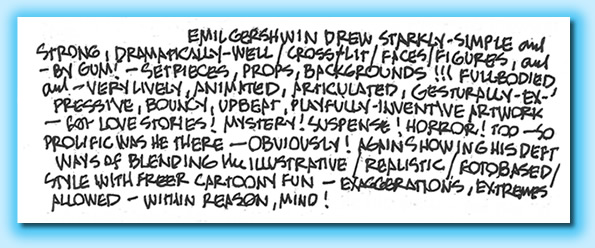
from Nancygershwin.com
Looking into the back stories of these elusive craftsmen reveals a shadow to the history of comic books, viewing the Golden Age through a scanner darkly, as we can see in the strange case of Ogden Whitney, responsible for the lurid color covers, as well as issue #13’s Lewis Carroll-inspired surrealism, “Beware The Jabberwock”.
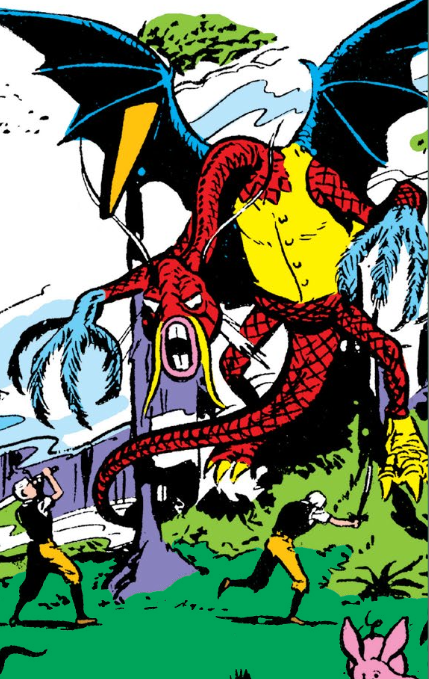
Ogden Whitney was a prolific anthology artist, during the Golden Age of the ’30s and ’40s, working on numerous genre titles like Forbidden Worlds, the war comic Commander Battle and the Atomic Sub, and the Western The Hooded Horseman. He also did some work for the majors, working on Marvel’s Western title The Two-Gun Kid, the romantic drama Millie The Model, as well as some pencil work for an issue of Nick Fury, Agent of S. H. I. E. L. D., in Strange Tales 149. He is perhaps best remembered as co-creator of the superhero Skyman, and the originator of comic’s most unlikely, and perhaps most powerful, superhero, Herbie Popnecker (and his alter ego Herbie The Fat Fury, described as Ogden’s comic book alter ego), which Alan Moore has claimed to be one of his favorite comics of all time.
While Whitney may hold the distinction of being one of two comics creators inducted into the Eisner Hall Of Fame as a “Judge’s Choice”, Whitney died obscure, alcoholic, and alone.
How did such a fate befall such a prolific and prodigious artist?
Whitney was just one of countless casualties in the war of attrition against comics in the early 1950s, thanks to Fredric Wertham’s incendiary Seduction Of The Innocent, leading up to the adoption of the Comics Authority Code. Genre titles, particularly horror books, like Adventures Into The Unknown, along with its more famous offspring Creepy and Eerie, would be some of the hardest hit, with its ghoulish subject matter of vampires, werewolves, and zombies forbidden by the new Comics Code, thanks to their “physical instruments associated with walking dead, or torture.” The Comics Code would usher in one of comics most insipid periods, creating the stereotype that comics are “kids’ stuff”, that persists to this day.
Somewhat ironically, Wertham’s diatribe would help to resuscitate the dwindling superhero genre, which was strongly associated with the New Deal/WWII world of the ’30s and ’40s. Superheroes were no longer hip, or edgy, or countercultural. In many ways, we have Wertham to thank for the creation of The Fantastic Four, Spider Man, and The X-Men.
Dark Horse’s foray into the Golden Age re-instates these pulp horrors in their proper place in the comic’s continuum, taking us back to a world where genre titles – horror, fantasy, SF, Westerns, war, and romance – dominated, making for a very different kind of comic book, that perhaps predicts the anything goes marketplace of today’s exploded indie and creator-owned scene.
All right, enough with the history lesson. How are the comics?
I’m glad you asked. As you might know, I am a complete gibbering horrorfiend, dedicated body and soul to tracing its origins and influences anywhere I may find it, so for me, these issues were a real treat. I find it fascinating to watch the pop cultural evolution, to see how we arrived at today.
Being a horror fanatic, I am obsessed with the minutiae, the details, the trappings – the dripping ick and gore, the gothic candelabra, the weird and steamy swamps and distant airy mountains. Anybody that gets off on the little details in horror stories will find much to exsanguinate about, here.
 Some personal highlights were “The Vampire Swoops”, the first story from issue #13, with strong pencil and ink artwork from Leonard Starr. It follows Dr. Thornton – a rugged, lantern-jawed man of SCIENCE!, along with Nurse Sylvia Harding, a buxom redhead, the archetypal maiden-in-distress, as they are sent to the desolate swamps of Louisiana, to visit a remote town called Charville, where there has been a strange outbreak of anemia.
Some personal highlights were “The Vampire Swoops”, the first story from issue #13, with strong pencil and ink artwork from Leonard Starr. It follows Dr. Thornton – a rugged, lantern-jawed man of SCIENCE!, along with Nurse Sylvia Harding, a buxom redhead, the archetypal maiden-in-distress, as they are sent to the desolate swamps of Louisiana, to visit a remote town called Charville, where there has been a strange outbreak of anemia.
Thornton and Nurse Harding are waylaid, en route, by the sinister Doctor Henry Charron, who has summoned the pair, and seems to be wearing the same colors as a strange oversized bat the pair saw in the swamps.
You can probably see where this is going – Charron is a vampire that has been feeding on the townsfolk for generations, turning them into ghoulish followers, trapped in a nightmarish half life.
Luckily for the town’s folk, Thornton happens to be an expert on chiroptera – a bat expert, and he has a flash of inspiration at the last second, to save the imperiled townsfolk. He makes a quick call to the army, who air drop a supersonic device. As the sun begins to set, Thornton lures Charron and his oversized bats to a patch of quicksand in the swamps, then uses the supersonic device to disorient the bats’ echolocation, making them blind. They revert to human form in a panic, and plummet to their doom.
The Vampire Swoops was a favorite, as it sets the tone for the whole collection, as pretty much EVERY SINGLE STORY in all 224 pages follows this template: an interpid man of science, a maidenly damsel in distress, a sinister villain, and, inevitably, the triumph of science over superstition.
The other standout, which makes Issue #13 a particularly strong entry, is Ogden’s “Beware The Jabberwock”, which I mentioned, already, briefly. It tells the tale of two unearthly twins, gifted with superhuman intelligence due to the father’s irradiation, who become obsessed with Lewis Carroll’s children books, particularly The Jabberwocky. The twins become convinced that there is a cypher buried in its gibberish, spending long nights cracking its code, which ultimately leads to a mirror portal into another world!
Come see the Frumious Bandersnatch, the fearsome jubjub bird, and ultimately, The Jabberwock, with its eyes full of flames. Its a creative, ambitious inclusion, that hearkens back to the classics, creating a new generation of Carroll lovers, bring his surreal daydreams into glorious four color life!
Okay, cool! So what were a few of your other favorites?
It would take a novella to fully dissect this tome’s 224 pages fully, so I will be brief and say that I, personally, loved “Face In The Moonstone”, with art by Charlie Sultan, for its inclusion of Lilith and the dark moon, which made it come off like some early Sailor Moon episode.
Probably my absolute favorite of the batch (maybe tied with The Jabberwock) was “The Ghostly Goths”, from Adventures Into The Unknown #15, with strong artwork by Edvward Munch, and not just because I’m pale and wear all black. The tale follows Dr. Charles Wentworth, the second best living authority on runic inscriptions into Torbsbaerg Boglands, where an ancient runic monument has been discovered. Wentworth copies the runes, when suddenly his buxom assistant Blanche’s portable phonograph starts spewing out gibberish, like an Anthrax record spun backwards, which teaches Wenthworthe the proper pronunciations. Speaking the runes out louds unleashes the spirits of The Ghostly Goths, who are bound to take revenge on those that disturbed the monument.
Wentworth is piqued, momentarily, until realizing that he has not disturbed the monument, which had already been defaced by “The Huns” a year prior. They soon realize “The Huns” are the Nazis, and The Ghostly Goths transport Wentworthe and Blanche to the mountains of South America, where the Nazis are hiding out.
The whole edition is worth it for the panel of a ghostly goth punching Adolph Hitler in the face, and that’s just one ghastly grin of many, in this dark spectacular.
Okay, there’s glory in the details. I’m going to pick it up. But first, how’s the writing?
Not great, most of the text would fall under what Stan Lee called “insipid text”, being guilty of the very worst forms of exposition. I tried to count how many times the word “unknown” was used in the volume, but lost track after 20.
The writing’s not great, but that’s okay. If anything it reveals a skeletal template of the horror/SF genre, boiled down to brass tack essentials, that could stand as an inspirational launchpad for people working in the field today.
But is it scary?
No, not really, which was one of the only downsides, for me. The material collected in Adventures Into The Unknown Archive #4 might be better considered supernatural or sci-fi thriller, as there seems to be no real threat of the good guys losing. It’s lacking the true tension to produce real terror, but this is some 60 years after the fact, and I’m likely to be jaded.
But, to quickly reiterate, for horror and SF lovers, there is glory in the details! For those of us obsessed with both genres, there’s NEVER enough haunted houses, NEVER enough rocket ships. We know the stories like the backs of our hands, and yet we want to see how they play out. We meet oddball characters in creepy, mysterious surroundings along the way, in search of mystery and imagination.
The Spirit Of The 1950s
So what do these four volumes tell us about the specter of the 1950s?
The thing that struck me the most, reading Adventures Into The Unknown Archive #4, was how they fervently seemed to believe that science and technology was going to win out, over everything. It was only a matter of time until progress would progress over all the huns, the vampires and Martians.
That being said, they still believed there were, or might be, vampires and Martians and zombies. By the time the ’80s and ’90s rolled around, when it would seem like a lot of these prophecies were being fulfilled, people no longer thought such things were possible. A certain segment of imagination and wonder had been lost.
In a way, the early ’50s could be seen as the true rainbow bridge between the spiritualism of the Victorian Age, and the rushing future.
Adventures Into The Unknown could be seen as the inversion of the tiki/exotica craze of the ’50s. People were fascinated with far-off places, which seemed to be edging ever-closer, with the creation of transistor radios and commercial jet liners. People’s imaginations were alive with exotic descriptions, brought back from GI’s. They were hungry for frontier to explore, adventures to be had, wonders unimaginable.
One other aspect of the ’50s on great display here, which I won’t go into much for the sake of space and the fact that it’s been written about extensively elsewhere, is the role that women play in these comics. I don’t think there is a single developed female character in the lot, apart from maybe the evil villainesses, but even they are just playing up a more interesting stereotype. The women are all nurses, assistants, and props to be rescued.
Just goes to show that people weren’t thinking much of our sisters and mothers, at the time, which is likely to detract from the enjoyment of this series for some, especially ardent feminists (or people weary of tired tropes and cliches). I found it a little annoying, to be honest, but wasn’t a deal breaker. Chalk it up to the spirit of the age.
So is it worth it?
If you love horror and SF then yes, absolutely! Dark Horse has been doing a great public service with these swank archival re-issues, giving these somewhat shadowy creators their just desserts and time in the sun. Also major, major bonus points for lavish presentation and, as ever with Dark Horse, they look amazing, lined up on the shelves!
Adventures into the Unknown Archives Volume 4 is out now on Dark Horse!
Dark Horse Comics Facebook
@DarkHorseComics
Dark Horse Comics homepage
Community Post: This article was submitted by a member of our community. The views expressed are the opinions of the designated author, and do not reflect the opinions of the Overmental as a whole or any other individual. We will gladly cooperate in the removal of plagiarism or any copyright infringement. Please contact us here.
